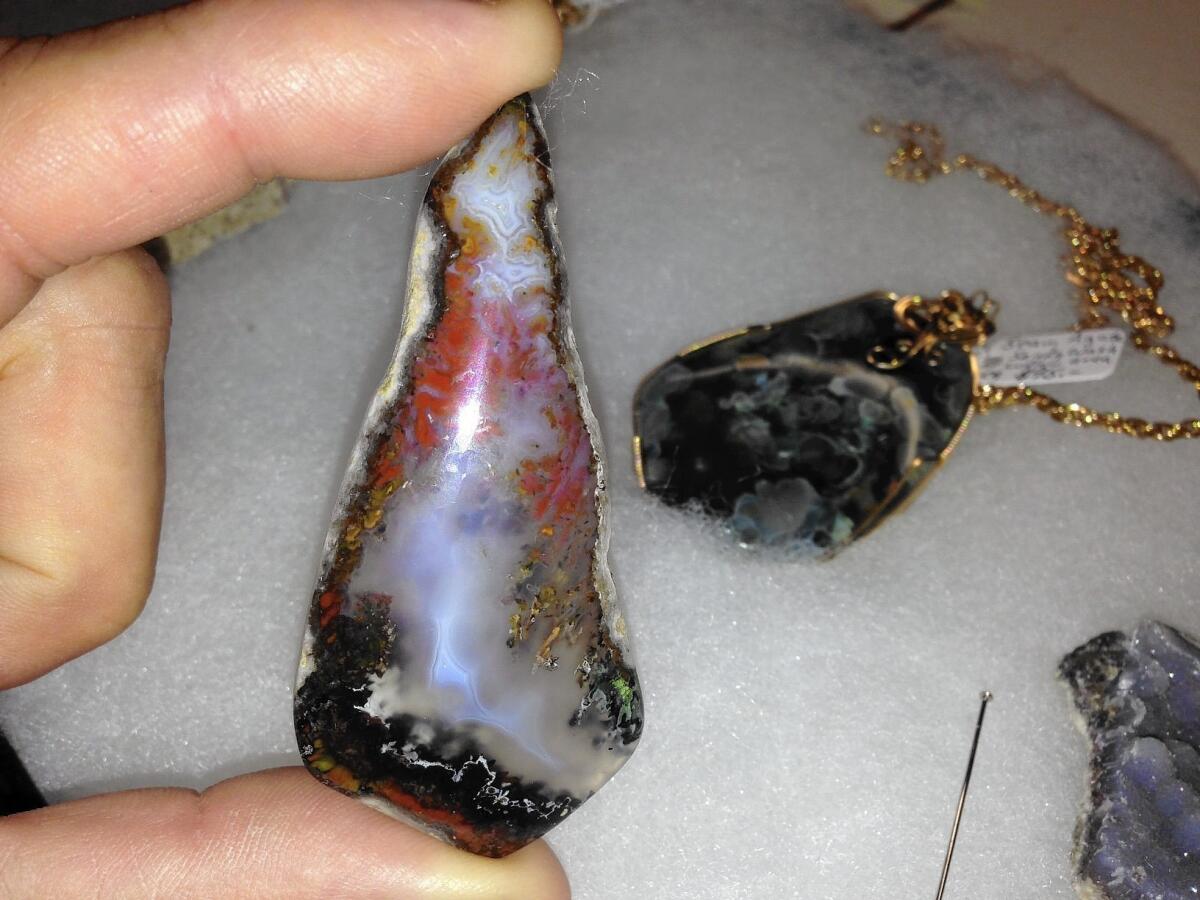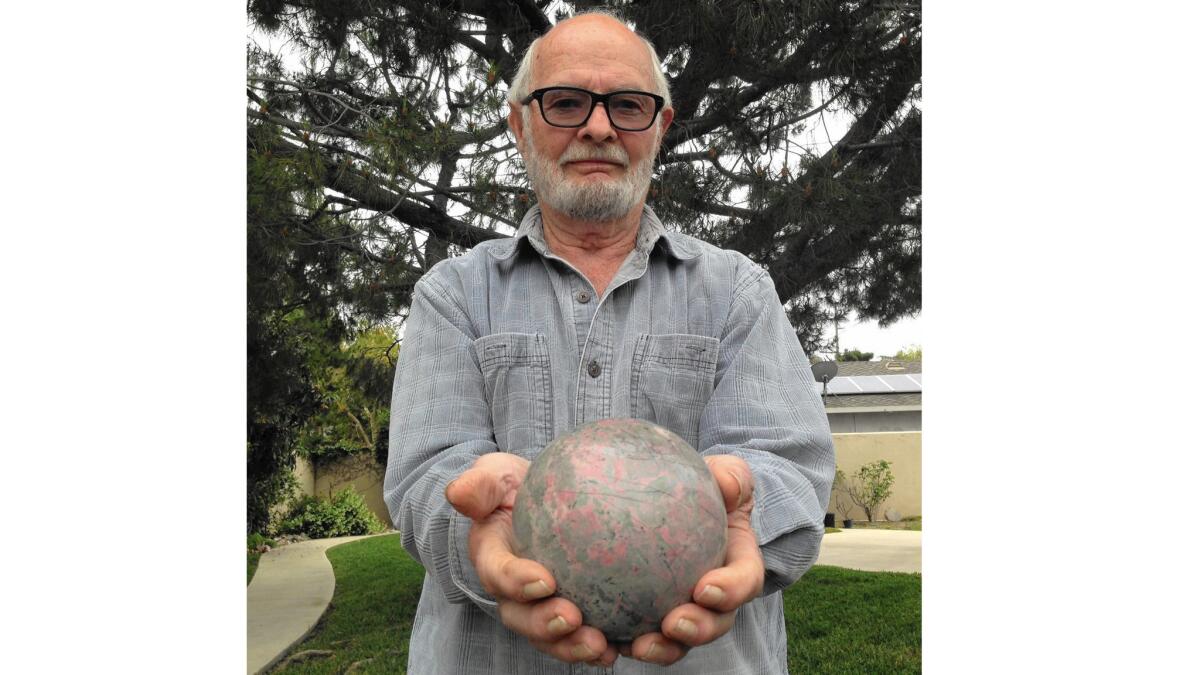A lost gem? New Mojave Trails monument rules appear to bar rock hunting

- Share via
President Obama’s proclamation of a new national monument he designated in California’s Mojave Desert has rockhounds worried they are no longer welcome on public lands with a reputation for prime gem and mineral specimens.
The proclamation ensures public access for utilities, cattle ranching, hiking, camping, backpacking, hunting, fishing, rock climbing, bicycling, bird watching and other outdoor recreational activities in Mojave Trails National Monument, which encompasses 1.6 million acres of federal land along a 105-mile stretch of old Route 66 between Ludlow and Needles.
The one thing visitors apparently can’t do in mineral hot spots, including Afton Canyon, the Cady Mountains and Lavic, is take a rock a home.
That’s because the proclamation does not include “rock hunting” as a desired use, and ends with an admonition: “Warning is hereby given to all unauthorized persons not to appropriate, injure, destroy, or remove any feature of the monument and not to locate or settle upon any of the lands thereof.”
Now, members of California’s relatively small and aging gem and mineral community fret that the loss of access to hunting grounds within a few hours’ drive of Los Angeles could hasten the demise of hobbyists who for generations have ventured out into the desert with shovels, picks and hammers to collect agate, jasper, opal, chalcedony and quartz crystals for noncommercial purposes.
“It’s an outrage and unfair that the only activity forbidden in this new national monument is our hobby,” said Kim Erbe, a member of the board of directors of the California Federation of Mineralogical Societies Inc. “People have been collecting rocks and minerals in that area for over a century.”
“It’s a mess,” said John Martin, webmaster at the American Lands Access Association, Inc., a nonprofit representing the rockhounding interests of 325 gem & mineral clubs and societies across the nation. “We’re seeking clarification on this matter, and we want it in writing.”
The U.S. Bureau of Land Management, which operates the new monument, and U.S. Sen. Dianne Feinstein, who spent two decades campaigning for the creation of Mojave Trails and two adjacent monuments, have sent out conflicting signals about the proclamation’s intent.
It’s an outrage and unfair that the only activity forbidden in this new national monument is our hobby.
— Kim Erbe, member of the board of directors of the California Federation of Mineralogical Societies Inc.
Maria Thi Mai, a spokeswoman for the land management bureau in Sacramento, said her agency “appreciates the rock hunters’ passion and concern, but we wouldn’t be in the public service business if we said it was OK to ignore the president’s proclamation.”
“So, we’re asking for their patience,” she added, “as we develop a formal management plan that will finalize what is allowed and what the limitations will be in the new national monument.”
Mike Ahrens, a field manager for the bureau’s office in Needles, Calif., agreed, up to a point. “We recognize that there is a problem for rock hunters with regard to the language in the proclamation,” he said. “I’m pushing for some kind of an interim action that would allow rock hunting to continue until a management plan is worked out.”
Developing a management plan will require the bureau to mediate compromises among all those who want access to the land while also planning a balanced and sustainable future for it — a contentious process expected to take at least 18 months to complete.
Feinstein’s office has added to the confusion by insisting that the proclamation’s warning against removal of “any feature of this monument” refers to cultural and historic items, not rocks.
Steve Duncan, a longtime member of the Searchers Gem & Mineral Society, is among those trying to make sense of it all.
“Before President Obama designated the new monument, Sen. Feinstein told me personally that she would ensure that rock collecting would be allowed in them,” he said. “After the designation, when I asked her office why we’d been left out of the proclamation, they responded with a form letter.”
Designation of Mojave Trails, Sand to Snow and Castle Mountains National Monuments was requested by Feinstein. Unable to gain momentum on her California Desert Conservation and Recreation Act last year, Feinstein asked Obama to act unilaterally to create the monuments overlapping biological zones between roughly Palm Springs and the Nevada border.
The designations, which did not come with funding, were supported by groups including the nonprofit National Parks Conservation Assn., the Sierra Club, Defenders of Wildlife, the Center for Biological Diversity and the Mojave Desert Land Trust.
On Thursday, hundreds of people from those groups and others gathered in a scenic desert canyon, about 15 miles northwest of Palm Springs, to celebrate the monuments and their access to public activities such as hunting, camping and hiking.
Interior Secretary Sally Jewell, the keynote speaker, said in an interview that she was unaware of the controversy over whether rocks can be removed from Mojave Trails. However, “we are thinking more these days about the long-term preservation of the assets in public lands,” she said.

Jim Peterson, 82, of Santa Ana, holds a rock sphere he created with lapidary equipment. The rock was collected on what is now Mojave Trails National Monument.
That kind of talk worries people who find joy in lugging a few bucketfuls of rocks home to be cut and polished with lapidary equipment. Some are turned into pendants, bolo ties, rings, bookends and colorful spheres. Others wind up in glass display cases, or in schoolrooms.
Take Jim Peterson, 82, and Norbert Bernhardt, 61, both of Santa Ana, whose fascination with rock specimens is reflected in their homes. Boxes of rocks are piled high, and drawers and shelves overflow with collections drawn on decades of journeys to remote corners of the Mojave.
Immediately after Obama’s designation, Peterson and Bernhardt headed out to the Cady Mountains in a pickup truck loaded with hammers, aluminum ladders and plastic buckets.
Their destination was a cliff face lined with a feature Bernhardt described as “a nice vein of gorgeous agate.”
“We figured we had little to lose before that place would be closed to rock collecting,” Bernhardt recalled with a sheepish smile. “So, we went out there and filled a few buckets with red, green, pink, blue, white and clear specimens.”
Bernhardt triumphantly held up a silver-dollar sized rock encrusted with tiny blue crystals and said, “This is what I’m talking about.”
Twitter:@LouisSahagun
ALSO
Restrictions on Children’s Pool beach in La Jolla are illegal, judge rules
Drug lord-themed Maywood restaurant has fans but isn’t to everyone’s taste
The wells have run dry in this California town, so why is a $1.2-million water system untapped?
More to Read
Sign up for Essential California
The most important California stories and recommendations in your inbox every morning.
You may occasionally receive promotional content from the Los Angeles Times.














